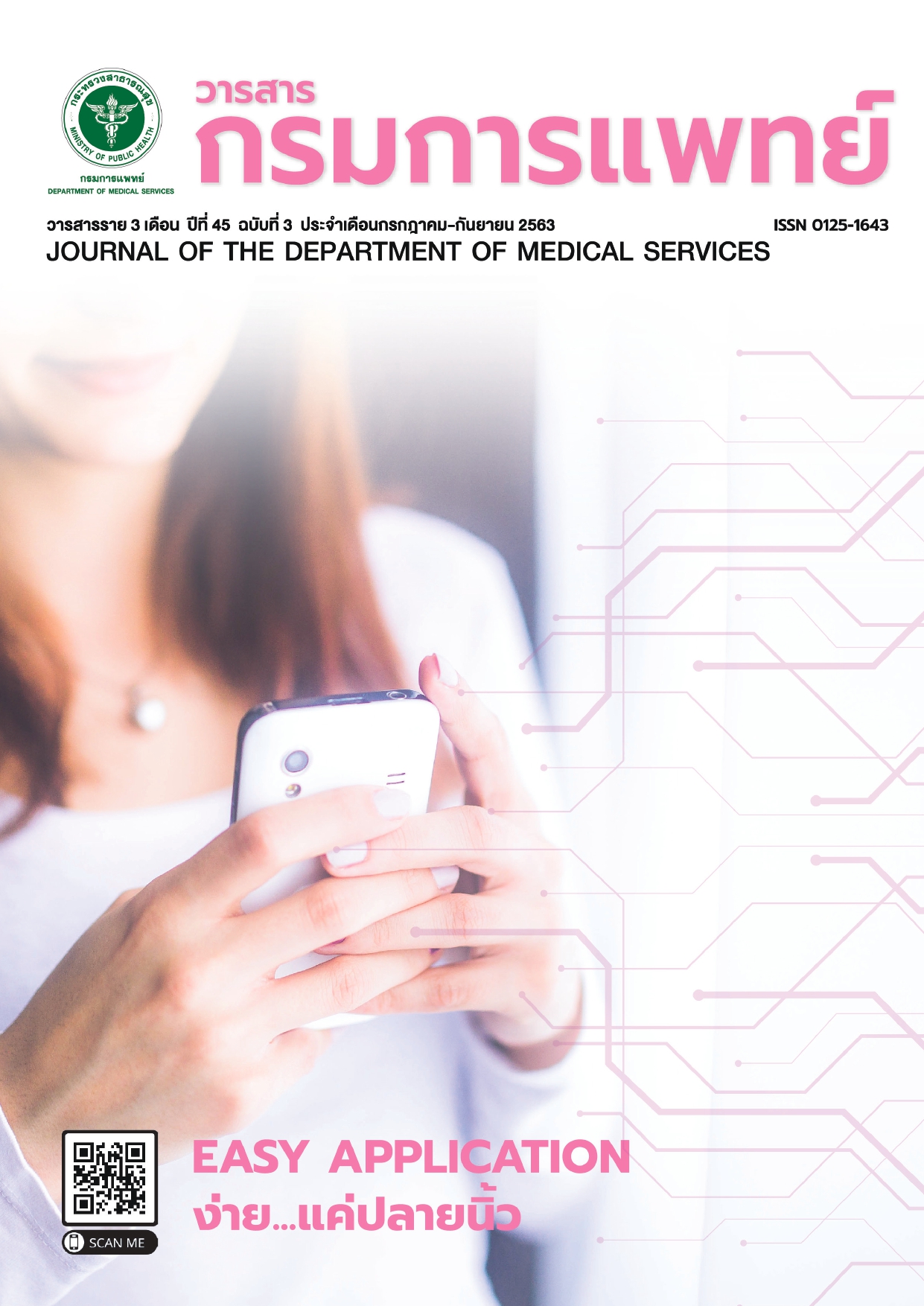ภาวะการณ์ความเสี่ยงฟันผุในผู้ป่วยที่มีภาวะโรคเบาหวานโดยใช้ โปรแกรม cariogram ในโรงพยาบาลสังขะ จังหวัดสุรินทร์
คำสำคัญ:
ความเสี่ยงการเกิดฟันผุ, แคริโอแกรม, ผู้ป่วยที่มีภาวะโรคเบาหวานบทคัดย่อ
ภูมิหลัง : โรคเบาหวานมีความสัมพันธ์กับโรคในช่องปาก ทั้ง โรคเหงือกอักเสบและโรคปริทันต์อักเสบ ส่วนการเกิดโรคฟันผุนั้นยัง มีข้อโต้แย้ง ทั้งนี้ cariogram เป็นเครื่องมือหนึ่งที่ใช้ในการประเมิน ความเสี่ยงในการเกิดฟันผุได้
วัตถุประสงค์ : ศึกษาภาวะการณ์ความ เสี่ยงในการเกิดฟันผุในผู้ป่วยที่มีภาวะโรคเบาหวาน ในโรงพยาบาล สังขะ จังหวัดสุรินทร์ โดยใช้ cariogram
วิธีการ : กลุ่มตัวอย่าง ทั้งหมด 201 ราย เป็นผู้ป่วยที่มีภาวะโรคเบาหวานทั้งชนิดที่ 1 และ ชนิดที่ 2 ดำเนินการเก็บข้อมูลระหว่างเดือนกันยายนถึงธันวาคม ปี 2561 โดยข้อมูลที่ได้มาจากการเก็บตัวอย่างน้ำลายและส่งตรวจ ทางห้องปฏิบัติการ เพื่อวัดจำนวนเชื้อสเตร็ปโตค็อกคัสมิวแทนส์ ความเป็นกรด-ด่างของน้ำลาย อัตราการหลั่งน้ำลาย การตอบ แบบสอบถามเกี่ยวกับปริมาณอาหาร ความถี่ในการรับประทาน อาหาร การได้รับฟลูออไรด์ ตรวจช่องปากโดยใช้แบบตรวจสภาวะ ช่องปาก ข้อมูลที่ได้ทั้งหมดนำมาประเมินความเสี่ยงในฟันผุของ แต่ละคนในกลุ่มตัวอย่างโดยใช้โปรแกรมแคริโอแกรม (cariogram)
ผล : ผู้ป่วยเบาหวานส่วนใหญ่เป็นเพศหญิงร้อยละ 75.1 อายุน้อย กว่า 60 ปี ร้อยละ 66.2 เป็นเบาหวานชนิดที่ 2 ร้อยละ 99.5 และ เป็นมามากกว่า 5 ปีร้อยละ 62.2 สภาวะช่องปากพบว่า กลุ่มตัวอย่าง มีค่าเฉลี่ยฟันผุ ถอน อุด (DMFT) 8.99 ซี่ต่อคน โดยผู้ป่วยที่มีภาวะ โรคเบาหวานมีค่าน้ำตาลในเลือดต่ำกว่าหรือเท่ากับ 130 มก/ดล มีค่าเฉลี่ยฟันผุ ถอน อุด 7.73 ซี่ต่อคน ขณะที่ผู้ป่วยที่มีภาวะโรค เบาหวานมีค่าน้ำตาลในเลือดต่ำสูงกว่า 130 มก/ดล มีค่าเฉลี่ยฟันผุ ถอน อุด 9.66 ซี่ต่อคน และผู้ป่วยที่มีอายุน้อยกว่า 60 ปีมีค่าเฉลี่ย ฟันผุ ถอน อุด 8.56 ซี่ต่อคน ส่วนผู้ป่วยที่มีอายุตั้งแต่ 60 ปีขึ้นไป มีค่าเฉลี่ยฟันผุ ถอน อุด 9.82 ซี่ต่อคน และเมื่อทำการประเมิน ความเสี่ยงการเกิดฟันผุพบว่า กลุ่มตัวอย่าง 170 ราย คิดเป็น ร้อยละ 84.58 มีค่าหลีกเลี่ยงการเกิดฟันผุอยู่ในช่วง 61–100 ซึ่ง จัดอยู่ในกลุ่มที่มีความเสี่ยงการเกิดฟันผุสูง
สรุป : ผู้ป่วยที่มีภาวะ โรคเบาหวานในโรงพยาบาลสังขะ จังหวัดสุรินทร์ มีความเสี่ยง ในการเกิดฟันผุสูง
References
Health promition policy research center. Report of NCDs. International health policy Program; 2016.
Derojanawong C, Pourvilai K. Diagnosis and classification of diabetes. Diabetes texts. The endocrine society of thailand. Bangkok: Ruen kaew printing house; 2003: 2-14.
American Diabetes Association. Report of the expert committee on the diagnosis and classification of diabetes mellitus. Diabetes Car 1997;20:1187-97.
Report of the 8th National survey of the state of oral health in thailand 2017. Department of health, ministry of health; 2018.
Survey of oral health status and dental behavior in surin province 2017. Surin : Surin Public oral health; 2018.
Heymann H, Swift EJ, Ritter AV, Sturdevant CM. Sturdevant’s art and science of operative dentistry. St. Louis,Mo: Elsevier/ Mosby; 2013.
Iqbal S, Kazmi F, Asad SK. Dental caries and diabetes mellitus. Pakistan Oral & Dental Journal 2011;31.
Seethalakshmi C, Seethalakshmi C, Jagat RC. Salivary markers of diabetes mellitus and oral status. Journal of Clinical and Diagnostic Research 2016;10:ZC12-4.
Hintao J, Teanpaisan R, Chongsuvivatwong V, Ratarasan C, Dahlen G. The microbiological profiles of saliva, supragingival and subgingival plaque and dental caries in adults with and without type 2 diabetes mellitus. Oral Microbiol Immunol 2007;22:175–81.
Saensorn W, Chatchaiwiwatana S, Bumrerrach S. Dibestis and oral health. KDJ 2010:13.
Jones RB, McCallum RM, Kay EJ, Kirkin V, McDonald P. Oral health and oral health behaviour in a population of diabetic outpatient clinic attenders. Community Dent Oral Epidemiol 1992;20:204-7.
Bacic M, Ciglar I, Granic M, Plancak D, Sutalo J. Dental status in a group of adult diabetic patients. Community Dent Oral Epidemiol 1989;17:313-6.
Bratthall D, Hänsel Petersson G, Stjernswärd JR. CARIOGRAM MANUAL. Stockholm: Förlagshuset Gothia; 1997.
Larmas M. Simple tests for caries susceptibility. Int Dent J 1985; 35:109-17.
Celik EU, Gokay N, Ates M. Efficiency of caries risk assessment in young adults using Cariogram. Eur J Dent 2012; 6:270-9.
Rafatjou R, Razavi Z, Tayebi S, Khalili M, Farhadian M. Dental Health Status and Hygiene in Children and Adolescents with Type 1 Diabetes Mellitus. J Res Health Sci 2016; 16:122-6.
Miralles L, Silvestre FJ, Hernández-Mijares A, Bautista D, Llambes F, Grau D. Dental caries in type 1 diabetics: influence of systemic factors of the disease upon the development of dental caries. Med Oral Patol Oral Cir Bucal 2006; 11:E256-60.
Seethalaks C, Jagat Redd RC, Asifa N. Correlation of Salivary pH, Incidence of Dental Caries and Periodontal Status in Diabetes Mellitus Patients: A Cross-sectional Study. Journal of Clinical and Diagnostic Research 2016; 10:ZC12-14.
Al-Khayoun JD, Diab BS. Dental caries, Mutans Streptococci, Lactobacilli and salivary status of type1 diabetic mellitus patients aged 18-22 years in relation to Glycated Haemoglobin. Journal of Baghdad College of Dentistry 2013; 325:1-6.
Collin HL, Uusitupa M, Niskanen L, Koivisto AM, Markkanen H, Meurman JH. Caries in patients with non-insulindependent diabetes mellitus. Oral Surg Oral Med Oral Pathol Oral Radiol Endod 1998; 85:680-5.
Ruiz-Miravet A, Montiel-Company JM, Almerich-Silla JM. Evaluation of caries risk in a young adult population.Med Oral Patol Oral Cir Bucal 2007; 12:E412-8.
Ligtenberg AJ, de Soet JJ, Veerman EC, Amerongen AV. Oral diseases from detection to diagnostics. Ann NY Acad Sci 2007; 1098:200–3.
Downloads
เผยแพร่แล้ว
How to Cite
ฉบับ
บท
License
บทความที่ได้รับการตีพิมพ์เป็นลิขสิทธิ์ของกรมการแพทย์ กระทรวงสาธารณสุข
ข้อความและข้อคิดเห็นต่างๆ เป็นของผู้เขียนบทความ ไม่ใช่ความเห็นของกองบรรณาธิการหรือของวารสารกรมการแพทย์


